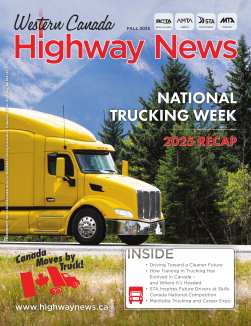
CTA Lauds Ideas to Remove Internal Trade Barriers as Potential Response to U.S. Tariffs
January 24, 2025
The Canadian Trucking Alliance is encouraged after the premiers and prime minister met yesterday to discuss Canada’s response to potential tariffs being implemented by the U.S. and agreed to have an urgent discussion around opportunities to increase internal trade within Canada –a move which would create increased efficiencies, productivity, and lead to greater resiliency in the face of these ongoing threats.

“CTA applauds the federal government and the provinces for looking at expediting a review of internal trade issues. Through a CTA led process, our sector has identified multiple inefficiencies that could be addressed to improve the productivity of the trucking supply chain and our competitiveness domestically,” said CTA’s Chair Greg Arndt.
The good news is that the trucking sector is already well positioned to participate in such a process. In the Fall of 2024, the Committee for Internal Trade Ministers met, and recognized the importance of domestic trade and the role trucking plays in the economy by establishing a series of pilot projects aimed at expediting the elimination of trade barriers and setting the country up for future success.
“Canada moves by truck, and bringing all levels of government together to identify and eliminate trade barriers is an important step to improving the movement of trucking equipment, drivers and goods. Removing internal trade barriers and changes, as well as changes andincreased enforcement tax and labour code is needed in short order to help restore competitiveness and productivity to the Canadian trucking industry and the Canadian supply chain,” said CTA president Stephen Laskowski.
The 2023 CTA report highlighted a series of trucking recommendations, and others that were selected by the Internal Trade Ministers, including topics such as: harmonization of long-combination vehicle requirements in Western Canada; inconsistencies related to how over dimensional loads move across provinces, amongst others.
According to information provided to CTA, the majority of provinces have joined the trucking pilot.
Considering the immediacy of the US tariff threat and the importance of taking additional measures to protect Canadians against the potential economic effects, the CTA is now encouraging the premiers to include items that will even bring greater benefits to the domestic supply chain, including:
- Complete the twinning of Highway 185 in Quebec: By finishing the last few kilometres of highway that needs to be twinned, goods moving by the most efficient trucking configuration in Canada will be allowed to operate from Halifax to Windsor – increasing efficiencies by up to 40%.
- Restoring U.S. In-Transit movements for Canadian fleets: U.S. trucks are allowed to utilize Canadian roadways to make domestic moves; for example, to make deliveries to Alaska via B.C., or deliveries from Detroit to Buffalo via Southern Ontario. Canadian trucks are not offered this same opportunity, although atemporary in-transit process made available in 2021 to aid in B.C. flood relief was very successful. Providing this ability to Canadian trucks would significantly reduce transit times and costs, optimizing the use of trucking equipment, reduce fuel consumption, among other benefits.
- Aligning and improving winter road Maintenance standards on the National Highway System (NHS) would bring predictability and confidence for the supply chain by reducing truck transit times across the country during winter months, particularly in areas with the harshest winter conditions like the Prairies and through the mountains in Alberta and B.C.
- Increased truck rest area locations and capacity. In many areas of the country and along the NHS that connects provinces and territories, there remains a lack of rest areas with adequate services and security to support all truck drivers. As well, the extended distances between facilities that exceed NHS design guidelines (they should be located every 1 to 2 hours driving time apart), creates unnecessary barriers to interprovincial goods movement.
CTA will be raising these issues in advance of the meeting next week and will encourage the premiers and the Government of Canada to make these matters a heightened priority.
Join us in creating a welcoming & successful environment.
Diversity, Equity, and Inclusion
We are now offering a self-paced program helping to foster an inclusive workplace, boost team morale, and improve company performance by embracing diverse perspectives and promoting equity.



